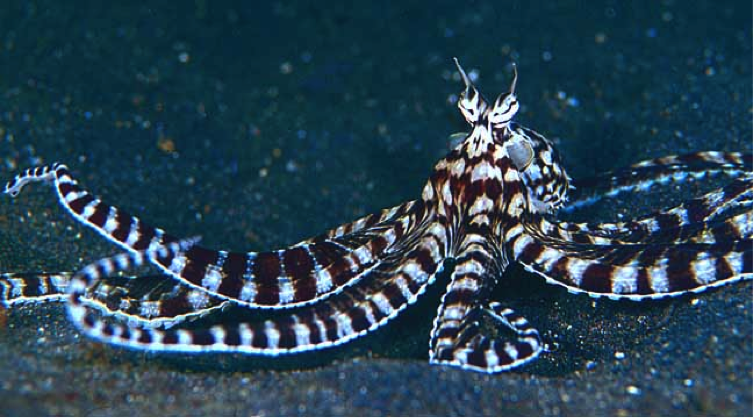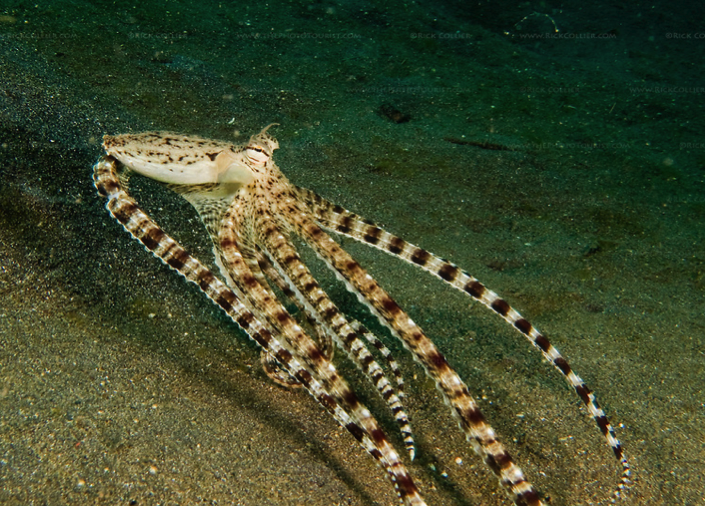Monkey….? No! Octopus See, Octopus Do!
I first came across the Mimic octopus, Thaumoctopus mimicus while I was browsing the Internet. I had read about the unique plumage of birds, special mating calls and behavior, but it was my first experience learning about an octopus with a variety of capabilities in mimicry of numerous poisonous or dangerous animals!! It was truly amazing and fascinating to learn about it!
Found in the waters of Southeast Asia and the Great Barrier Reef, its resting coloration consists of brown and white stripes or spots. It mimics other animals through changing both its coloration and body posture, and also like other cephalopods, it can mimic its surroundings or background. With the ability to transform into an impressive repertoire of postures and body patterns, the Mimic Octopus mimics numerous animals such as venomous sole, sea snakes, jellyfish, lionfish, sea anemones and etc. This form of mimicry is also known as the Batesian mimicry, where an animal evolves a pattern resembling that of a dangerous species so as to gain protection from predators.
For example, they would swim just above the sea floor with their arms trailing from their body, to mimic the image of a lionfish swimming with its poisonous spines fully flared. To mimic a fish-eating sea anemone anemone, it raises all of its arms above its head, curving each arm in zig-zag shape in order to represent the lethal tentacles. With regards to mimicking a jellyfish, its swims up to the surface and slowly sinks, spreading its arms evenly around its body.
Observations have shown that the Mimic Octopus uses a particular form of mimicry when in defense against threats or attacks. When attacked by territorial damselfishes, it would react by mimicking sea snakes as they are the predators of damselfishes. They also use aggressive mimicry to approach their prey, to deceive them and making it easier for them to devour their prey. For example, it mimicks a crab as a potential mate, only to eat it up right after. This hence shows that it is “able to use its power of deception facultatively”. (M.D.Norman, 2001)
This genus of octopus possesses unique characters that allow them to mimic other animals so easily. It includes the absence of a calamus on their copulatory organ, absence of enlarged suckers in either sex, long narrow arms capable of arm autotomy and distinctive base components of colour patterns.
Check out how amazingly similar and ingenious the Mimic Octopus is in the videos below!
http://www.youtube.com/watch?v=f3bzR3Sqla8&feature=endscreen
References:
Morgan, M. D., Julian, F., & Tregenza, T. (2001). Dynamic Mimicry in an Indo-Malayan Octopus. The Royal Society, 1755-1758. Retrieved from doi 10.1098/rspb.2001.1708
Norman, M. D., & Hochberg, F. G. (2005). The “Mimic Octopus” (Thaumoctopus mimicus n. gen. et sp.), a new octopus from the tropical Indo-West Pacific. Molluscan Research, 25(2), 57-70. Retrieved from http://www.mapress.com/mr/content/v25/2005f/n2p070.htm
Roger T. Hanlon, Anya C. Watson and Alexandra Barbosa. Biological Bulletin , Vol. 218, No. 1 (Feb., 2010), pp. 15-24


